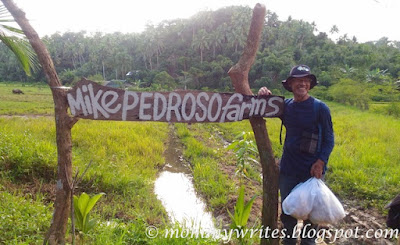Nestled at the foot of a hill in Carayman, Calbayog in Samar, Eastern Visayas is an integrated diversified organic farm that started as a dream. Back in 1986, Engr. Mike Pedroso was still working in the corporate world when he became, what he called, an "armchair farmer."
"I was a subscriber of an agriculture magazine for two years. Reading them was how my love for farming developed," he recalled. In 1994, Mike had an accident that left him immobile for 21 days and had him underwent physical rehabilitation for four months. He spent this time making plans to go into farming someday.
Finally, he decided to leave the corporate jungle in 1999 and began cultivating his piece of land by walking a kilometer each day carrying five seedlings to plant. "It was only then that I realized the magnitude of challenges our farmers face and why many of them remain poor," he confided, lamenting that farm-to-market roads are not being given priority by the government. Instead, the infrastructure budgets mostly go to the continuous repairs and improvements of highways and main thoroughfares.
For the first five years, Mike worked on his farm alone due to lack of funds to pay workers as his three children were still in school. "It's only now that I am able to hire people to help me." He then described his property as a trial and error farm. "Mostly error," he chuckled. "But new farmers are lucky because they could learn from our mistakes."
In 2002, Mike started his jackfruit orchard using seedlings from Abuyog, Leyte, which is around six to eight hours' drive away. "It's the place where you can find good quality planting materials, especially fruit trees. All jackfruit trees here came from Abuyog," he affirmed and added that he chose to plant the EVIARC (Eastern Visayas Integrated Agricultural Research Center) Sweet Variety.
The jolly farmer also admitted that his farm initially became "organic by neglect" due to lack of financial resources to regularly buy commercial fertilizer. "But starting 2008, the farm was really, completely organic." Although his main crop was jackfruit, Mike also developed an area for rice planting.
And since crops need organic fertilizer, he went into vermicomposting and raised goats for their manure. Later, Mike ventured into vegetable gardening, acquired carabaos, raised native chicken, and started with swine production.
Having the foresight that when more people started venturing into agriculture, Mike knew they would definitely need planting materials. "So I also established a plant nursery, which has become my bread and butter because the rice fields have been barren for three seasons and the jackfruit trees have been attacked by pests." Seedlings at Mike Pedroso Farms are sold at P65 each for the 8 to 10 month olds and P150 each if more than one year old. Afterwards, it will only take 3 to 4 years before jackfruit can already be harvested because the seedlings were grown using scion from a good quality mother tree that has been grafted to a rootstock.
To further understand and improve his crop, he joined forces with other jackfruit industry stakeholders and co-authored a study entitled 'Integrated Management of Phytophthora Disease of Jackfruit in the Southern Philippines.' According to Mike, the study involved all aspects of jackfruit from nursery up to production that would help farmers, regardless of background and capacity, to increase their yields and income. "It's very comprehensive because it's a collaboration between scientists, farmers, and extension workers."
 |
| Trivia: there are 304 organic jackfruit trees in Mike Pedroso Farms' 2-hectare orchard fruits harvested average 12 to 15kg each |
As to his farm's future developments, Mike plans on making his place a wellness haven by laying down jogging pathways and offering healthy beverages to joggers. "We will also put up obstacle courses," he revealed.
"I attended a farm tourism seminar and we were told you have to have something unique in your place for people to want to visit. So don't be surprised if you come back next year and I'll have a handkerchief tied on my head … kasi wellness … so albularyo na ako!" he announced with much humor.
Later, I and my fellow Organic Agriculture Bloggers planted a lauan tree each in Mike's farm as part of the Organikanong Magsasaka ng Rehiyon Otso (OMRO) Lakbay-Alay Tour. Instead of tree planting, they called it a Tree Growing Project so that people would be encouraged to visit their trees in the future to see how they've grown. Seriously, I'd love to go back to Calbayog someday and see my tree again! Stayed tuned for more about OMRO and its many worthwhile advocacies in my next blog post.
Asked why he chose to become an organic farmer, Mike's reply was simple: "I started farming because I wanted to pursue a healthy lifestyle. These days, it's hard to find food that is not contaminated. So, if you want to be sure about what you're eating, you have to grow your own."













No comments:
Post a Comment